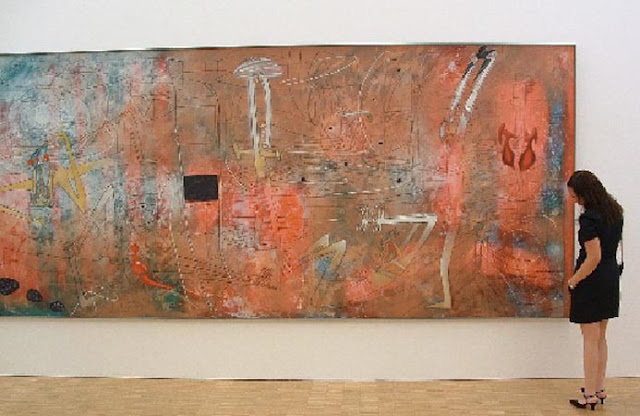How about a bit of surrealism for a change? Roberto Matta (1911 � 2002) known as Matta, was one of Chile�s best-known painters and a seminal figure in 20th century abstract expressionist and surrealist art.
Born in Santiago he initially studied architecture at the Pontificia Universidad Cat�lica de Chile in Santiago, but became disillusioned with this occupation and left for Paris in 1933. His travels in Europe and the USA led him to meet artists such as Arshile Gorky, Ren� Magritte, Salvador Dal�, Andr� Breton, and Le Corbusier.
It was Breton who provided the major spur to Matta�s direction in art, encouraging his work and introducing him to the leading members of the Paris Surrealist movement. Matta produced illustrations and articles for Surrealist journals such as
Minotaure. During this period he was introduced to the work of many prominent contemporary European artists, such as Pablo Picasso and Marcel Duchamp.
The first true flowering of Matta's own art came in 1938, when he moved from drawing to the oil painting for which he is best known. This period coincided with his emigration to the United States, where he lived until 1948. His early paintings, such as
Invasion of the Night, give an indication of the work he would continue, with diffuse light patterns and bold lines on a featureless background.
 |
| 1940 Invasion of the Night |
During the 1940s and 1950s, the disturbing state of world politics found reflection in Matta's work, with the canvases becoming busy with images of electrical machinery and distressed figures. The addition of clay to Matta's paintings in the early 1960s lent an added dimension to the distortions.
Matta's connections with Breton's surrealist movement were severed when a private disagreement concerning Arshile Gorky and his family (when Matta was accused of indirectly causing the suicide of Gorky because of Matta's relationship with the wife of the Armenian-American painter), and led to his expulsion from the group, but by this time his own name was becoming widely known.
He divided his life between Europe and South America during the 1950s and 1960s, successfully combining the political and the semi-abstract in epic surreal canvases. Matta believed that art and poetry can change the lives of people, and was very involved in the social movements of the 1960s and 1970s. He was a strong supporter of the socialist government of president Salvador Allende in Chile. A 4 x 24 metre mural of his entitled The First Goal of the Chilean People was painted over with 16 coats of paint by the military regime of Augusto Pinochet following their violent overthrow of Salvador Allende in 1973. In 2005 the mural was discovered by local officials. In 2008 the mural was completely restored at a cost of $43,000, and is displayed today in Santiago at the La Granja city hall. (I haven�t shown it here because frankly I think it has more political than artistic merit).
Matta died in Italy in 2002. Matta is the father of the artists Gordon Matta-Clark and his twin brother Sebastian, and Ramuntcho Matta. See my next post for the work of contemporary artist Gordon Matta-Clark.
 |
| 1937 Untitled |
Is it just me or does the painting above remind one of David Hockney's VN (Very New) Paintings, done in the early 1990's - see below:
 |
| DAVID HOCKNEY 1992 Twentyfourth VN Painting |
 |
| 1937 Untitled |
 |
| 1938 Morphologie psychologique de l'attente |
 |
| 1938 Morphologie psychologique de l'espour |
 |
| 1940 Lightforms |
 |
| 1941 L'e`ternite du fini |
 |
| 1942 The Disasters of Mysticism |
 |
| 1943 Eronisme |
 |
| 1945 X-Space and the Ego |
 |
| 1949 Untitled |
 |
| 1952 Let any Flowers Bloom |
 |
| 1954 Untitled |
 |
| 1958 L'Etang de No |
 |
| 1961 Instinct Caliban |
 |
| 1965 Untitled |
 |
| 1967 Semeur d'incendies |
 |
| 1974-76 Wake |
 |
| 1982 Le je et moi |
 |
| 1983 Fiat Lux |
 |
| 1990 El cosmos de la hierba |
 |
| 1997 Ecce Homo |
The presentation of these low resolution jpg files add more than words alone could impart. It is believed that this is fair use and does not infringe copyright. According to section 107 of the United States Copyright Act of 1976: The fair use of a copyrighted work�for purposes such as criticism, comment, news reporting, teaching, scholarship, or research, is not an infringement of copyright. The images are used for non-profit purposes. This factor is noted as relevant by the Act.


































Tidak ada komentar :
Posting Komentar